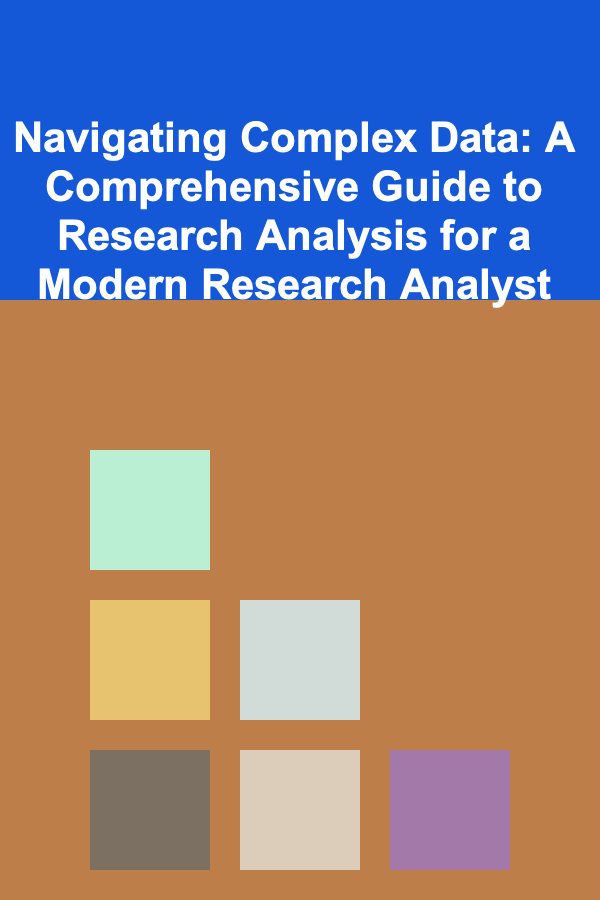
Navigating Complex Data: A Comprehensive Guide to Research Analysis for a Modern Research Analyst
ebook include PDF & Audio bundle (Micro Guide)
$12.99$7.99
Limited Time Offer! Order within the next:

In the ever-evolving landscape of modern business, research analysts are at the heart of decision-making processes. With an overwhelming amount of data available at our fingertips, the ability to make sense of this data and translate it into actionable insights has become more crucial than ever. This guide explores how a modern research analyst can navigate complex data and deliver insights that drive business success.
Understanding the Role of a Research Analyst
Before diving into the intricacies of data analysis, it's important to understand the role of a research analyst in the modern business environment. Research analysts are tasked with collecting, processing, and analyzing data to identify patterns, trends, and insights that can inform strategic decisions. Their work spans various industries, from finance and healthcare to technology and marketing.
Key Responsibilities
- Data Collection: Gathering raw data from diverse sources, including surveys, reports, databases, and third-party data providers.
- Data Cleaning and Preparation: Ensuring that data is accurate, complete, and in a format suitable for analysis. This can involve handling missing data, outliers, and inconsistencies.
- Analysis: Using statistical methods and analytical tools to extract meaningful insights from data.
- Reporting: Presenting findings in a clear, concise manner to stakeholders, often through reports, dashboards, and presentations.
- Recommending Action: Based on insights, analysts often provide recommendations for business strategies or improvements.
The Complexity of Modern Data
The increasing complexity of data makes research analysis a challenging task. In the past, analysts often worked with relatively simple datasets, which were structured and easy to process. Today, however, data comes in various forms, from structured data stored in relational databases to unstructured data such as text, images, and videos.
Types of Data Analysts Handle
- Structured Data: This data is organized into rows and columns, often in databases or spreadsheets. It's easy to analyze using traditional tools like SQL and Excel.
- Unstructured Data: This data lacks a predefined structure, such as social media posts, customer reviews, or video content. Analysts must often use more sophisticated methods like natural language processing (NLP) or image recognition to extract insights.
- Semi-Structured Data: Data that doesn't fit neatly into a table but still contains some organizational structure, such as JSON or XML files. Analysts need specialized tools to parse and analyze this data.
The complexity of modern data also comes from its sheer volume. Big Data refers to datasets so large and complex that traditional data processing applications are inadequate to handle them. Analyzing big data often requires distributed computing frameworks like Hadoop and Apache Spark.
Tools and Techniques for Navigating Complex Data
A modern research analyst needs a diverse toolkit to manage and analyze data effectively. The choice of tools depends on the nature of the data, the analysis requirements, and the analyst's expertise. Below are some of the most commonly used tools and techniques:
1. Data Cleaning and Preprocessing Tools
Before any meaningful analysis can occur, data needs to be cleaned and preprocessed. This step involves removing duplicates, handling missing values, normalizing data, and transforming it into a usable format.
- Python Libraries : Python is a go-to language for data preprocessing. Libraries like Pandas are widely used for data manipulation and cleaning. They provide powerful functions for handling missing data, filtering rows, and transforming columns.
- Excel: Despite the advent of more complex tools, Excel remains one of the most popular tools for data cleaning and basic analysis. Its easy-to-use interface allows analysts to quickly filter and clean datasets.
- Data Wrangling Tools : Tools like OpenRefine or Trifacta can help with more advanced data wrangling tasks, such as dealing with messy, inconsistent data.
2. Statistical Analysis Tools
Statistical analysis forms the backbone of most research analysis, as it helps analysts identify trends, relationships, and correlations within the data.
- R: R is one of the most widely used tools for statistical analysis and data visualization. It's known for its extensive library of statistical functions, including regression models, hypothesis testing, and more.
- SAS: Another powerful tool for statistical analysis, SAS is particularly favored by industries like finance and healthcare for complex statistical modeling.
- SPSS: SPSS is a user-friendly tool used for conducting basic and advanced statistical analyses. It's especially popular in academic research.
3. Data Visualization Tools
Visualization is key to communicating complex data findings in a clear and actionable manner. Research analysts often rely on data visualization tools to create intuitive graphs, charts, and dashboards.
- Tableau: Tableau is one of the most popular data visualization tools, known for its ability to create interactive and dynamic dashboards that allow users to explore data in real-time.
- Power BI: A business analytics tool by Microsoft, Power BI offers similar capabilities to Tableau and is often integrated into Microsoft's ecosystem, making it easy to import data from Excel or SQL Server.
- Matplotlib & Seaborn : For those who prefer coding over graphical interfaces, Python's Matplotlib and Seaborn libraries are excellent choices for creating static, animated, and interactive visualizations.
4. Machine Learning and Predictive Analytics
As data complexity increases, the need for predictive analytics and machine learning also grows. Research analysts are increasingly using these techniques to identify patterns and make forecasts.
- Python & Scikit-learn : Python's Scikit-learn is a popular library for machine learning. It includes tools for classification, regression, clustering, and dimensionality reduction, making it essential for analysts looking to apply machine learning to their data.
- TensorFlow : For more advanced machine learning models, especially those involving deep learning, TensorFlow (developed by Google) provides a powerful framework for building complex models.
- Time Series Analysis : Many businesses rely on time-series data (data collected at regular intervals over time), and analyzing this data requires specialized techniques. Tools like ARIMA models or Facebook Prophet can help in forecasting trends based on historical data.
5. Big Data Tools
Handling large datasets often requires distributed computing tools that can process data across many machines. These tools allow analysts to work with datasets that would otherwise be too large for traditional methods.
- Hadoop: An open-source framework that allows for distributed storage and processing of large datasets. Analysts use Hadoop to store and analyze data across multiple servers, breaking down the data into smaller, manageable chunks.
- Apache Spark : Built on top of Hadoop, Spark is a fast, in-memory data processing engine that allows analysts to perform large-scale data processing and advanced analytics.
Techniques for Navigating Complex Data
Navigating complex data goes beyond the use of tools. Research analysts must develop a robust set of techniques for understanding, analyzing, and deriving insights from data. Below are some techniques that can help:
1. Exploratory Data Analysis (EDA)
EDA is a technique used to summarize the main characteristics of a dataset, often visualizing the data before applying more formal statistical analysis. It involves:
- Descriptive Statistics: Calculating measures like mean, median, standard deviation, and percentiles to understand the data's central tendency and variability.
- Visualization: Creating histograms, box plots, and scatter plots to visually identify patterns, trends, and outliers in the data.
2. Hypothesis Testing
Hypothesis testing involves making an assumption about the data (the null hypothesis) and using statistical tests to determine whether the data supports or refutes that assumption. Common tests include:
- T-tests: Comparing the means of two groups.
- Chi-square tests: Assessing the relationship between categorical variables.
- ANOVA: Analyzing the differences between group means.
3. Regression Analysis
Regression analysis helps analysts model relationships between variables and predict future outcomes. It's used for:
- Linear Regression: Understanding the relationship between a dependent variable and one or more independent variables.
- Logistic Regression: Modeling binary outcomes (e.g., yes/no decisions).
- Multiple Regression: Analyzing the impact of several predictors on a single outcome.
4. Clustering and Segmentation
Clustering is a technique used to group similar data points together. It is widely used for customer segmentation and market research. Common algorithms include:
- K-means Clustering: A popular algorithm for partitioning data into clusters based on similarity.
- Hierarchical Clustering: A technique that builds a tree of clusters, useful for understanding the hierarchical relationships between data points.
5. Dimensionality Reduction
When dealing with large datasets with many variables, dimensionality reduction techniques help reduce the complexity of the data while retaining the most important features.
- Principal Component Analysis (PCA): A technique used to transform high-dimensional data into fewer dimensions for analysis.
- t-SNE: A technique often used for visualizing high-dimensional data in two or three dimensions.
The Importance of Contextualizing Data
While technical skills are crucial, the ability to contextualize data is what separates good analysts from great ones. Understanding the business context is essential for making sense of the data and offering actionable insights. Analysts should:
- Align Findings with Business Goals: Make sure that the analysis addresses the key business objectives.
- Engage with Stakeholders: Collaborate with different departments to understand their pain points and how data can help solve their problems.
- Understand Limitations: Acknowledge the limitations of the data and analysis. Not all data will provide clear answers, and acknowledging uncertainty can lead to more thoughtful recommendations.
Conclusion
Navigating complex data is an art as much as it is a science. For modern research analysts, mastering the tools, techniques, and methodologies to analyze data is essential, but the real value comes from the ability to translate data into meaningful, actionable insights that drive business success. Whether you're dealing with structured data, big data, or unstructured data, the key is to approach it methodically, keep learning, and always stay focused on delivering value to your organization.

Common Affordable Auto Repairs You Can Do Yourself
Read More
How to Maximize Storage in Your Bedroom Without Taking Up Space
Read More
How to Secure Financing for Your First Investment Property
Read More
How to Use Paint to Transform Your Home on a Budget
Read More
How To Write a Cover Letter That Lands Interviews
Read More
10 Tips for Maintaining Horse Pasture Health: A Seasonal Checklist
Read MoreOther Products

Common Affordable Auto Repairs You Can Do Yourself
Read More
How to Maximize Storage in Your Bedroom Without Taking Up Space
Read More
How to Secure Financing for Your First Investment Property
Read More
How to Use Paint to Transform Your Home on a Budget
Read More
How To Write a Cover Letter That Lands Interviews
Read More